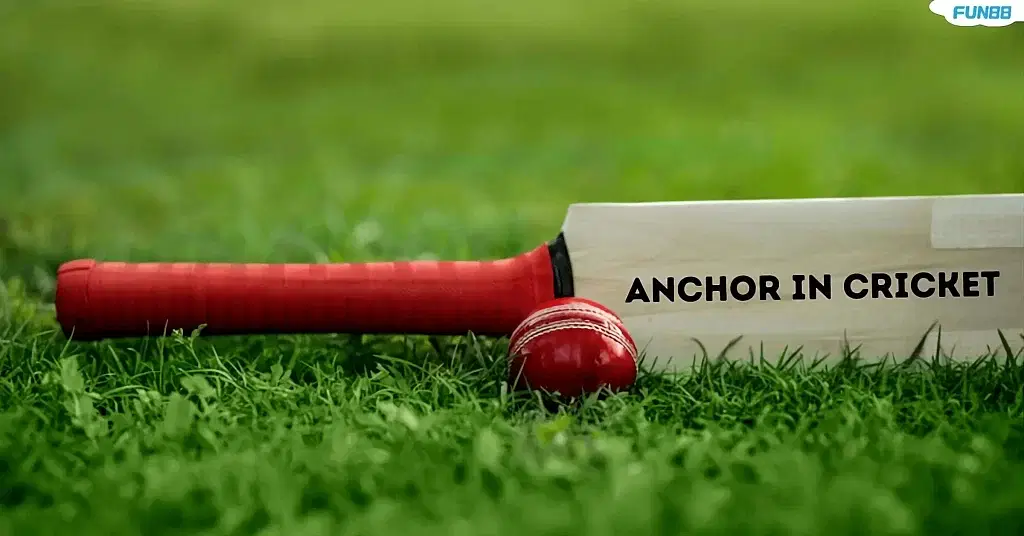Cricket, a sport of intricate strategies and subtle nuances, demands a diverse range of skills from its players. Among the various roles in batting, the anchor in cricket holds significant importance, providing both stability and control to an innings.
This post will meticulously explore what it means to be an anchor in the batting order, highlighting the responsibilities, strategic importance, and impact an anchor can have on the outcome of a match.
The Essence of an Anchor Role in Cricket
The term “anchor” in batting context takes inspiration from its nautical namesake—designed to hold things steady amidst turbulent waters. In cricket, an anchor batsman is tasked with maintaining the composure of the innings, especially when wickets are falling at the other end. This role demands not only technical skills but also a calm temperament.
The Core Responsibilities
- Consolidation: Anchors work to consolidate the innings, making sure that, even if the team loses quick wickets, they can hold through the middle sections of the innings, facilitating recovery.
- Forming Partnerships: Building crucial partnerships often falls on the shoulders of the anchor. They adapt to the game’s ebbs and flows, forming collaborative efforts to move the scoreboard.
- Handling Pressure Situations: A match is often intense. The anchor must face challenging bowlers, rotate the strike efficiently, and maintain composure.
- Balancing Act of Aggression and Defense: Choosing when to attack or defend depends on the scenario, and the anchor finely tunes this balance, preventing reckless dismissals while ensuring runs continue to flow.
Historical Context and Evolution
While the concept of an anchor is not new, its evolution through different formats adds a layer of intrigue. Traditionally, the role was more evident in Test cricket—known for its longer format and the necessity of enduring resilience. Anchors in Test cricket would often play grinding innings, wearing down bowlers as they went.
As limited-overs formats emerged, the definition expanded. In ODIs and T20s, maintaining a quick scoring rate is critical, prompting anchors to evolve. Their challenge now includes providing stability without letting go of the game’s momentum.
Related Read: What is a Dot Ball in Cricket? Explanation and Importance
Characteristics of an Effective Anchor
- Technical Proficiency: The foundation of an anchor’s success lies in their technique. They must command solid footwork, immaculate timing, and an eye for gaps to manipulate the field.
- Mental Fortitude: Situational awareness defines a good anchor. Knowing when and how to adjust play, especially when conditions and bowling attacks are unfriendly, is key.
- Versatility: An anchor’s role can morph according to the situation—sometimes staying defensive, sometimes counter-attacking—and thus, versatility is critical.
- Fitness and Stamina: Sustained concentration requires supreme fitness levels, enabling the anchor to guide the innings for extensive periods.
How an Anchor Influences Match Dynamics?
The presence of an anchor can transform the outlook of any inning. With their steadiness, they bring an element of predictability to the team’s plans, laying a platform for stroke-makers and ensuring lower-order batters have room to express themselves freely.
Scenarios Impacted by Anchors
- Chasing a Stiff Target: An anchor helps manage the run chase in pressure chases, preventing panic and imparting a plan alongside aggressive partners.
- Restricting Collapses: Amidst a collapse, the anchor becomes a safe haven, often sparking the recovery with calculated risks and guided partnerships.
- Early Overs in ODIs: By absorbing initial pressure from fast bowlers in opening spells, anchors provide sanity to one-day innings, setting up for accelerated scoring in the later stages.
Famous Anchors in Cricket History
Over the years, several iconic players have embodied the essence of an anchor, scripting some of cricket’s unforgettable innings. Rahul Dravid, often referred to as ‘The Wall,’ excelled with consistent displays of stoic resolve during his prime.
Similarly, players like Kane Williamson and Joe Root exemplify modern-era anchoring, balancing innings with extraordinary precision.
Tactics for a Modern-Day Anchor
- Playing the Situation: One of the pivotal aspects is to thoroughly understand the match condition, analyse bowlers’ strategies and adapt accordingly. For instance, pacing the innings based on powerplay rules or death overs requires astute judgment.
- Smart Use of Technology and Analytics: Today’s anchors utilise analytical tools to understand bowler tendencies, field setups, and strike areas, thus strategically planning their innings.
- Communication and Leadership: Communication with non-strikers is essential for serving as the central figure in partnerships, guiding younger players, and aligning the team strategy as the match unfolds.
Challenges Faced by Anchors
Despite the strength they offer, anchoring has its challenges. Criticism often circles around slower scoring rates, particularly in T20 formats where fast scoring is prioritised.
Adapting to rapidly changing cricket cultures and expectations doesn’t always align with the anchor’s traditional approach, which demands skilled negotiation of batting speed without compromising the team’s structural needs.
The Psychological Edge of an Anchor in Cricket
In Cricket, where strategy and skill intertwine, the psychological dimension of being an anchor in cricket cannot be overlooked. While much focus is on the technique and tactical role, an anchor’s mental strength is pivotal in defining their effectiveness during a match.
At the heart of the anchor role lies the need for exceptional composure. Cricket is famously unpredictable, with fortunes oscillating rapidly from one moment to the next. Anchors must harness their mental resilience to remain unfazed by such swings.
When wickets tumble at the other end, their steadfast approach can stabilise the team’s mental state, instilling confidence and providing a beacon of assurance.
Moreover, the anchor’s attitude influences the morale of the entire side. Projecting calm and calculating judgment helps maintain a positive atmosphere, preventing the panic that often sets in under pressure. This role transcends mere run accumulation; it is about leadership through example, fostering a team ethos where calculated risk-taking is backed by thoughtful preparation.
Consider the psychological warfare when facing quality bowling attacks. An anchor must not only contend with hostile deliveries but also stave off the mental games bowlers play. Their strategy might include subtle shifts in tactics to disrupt a bowler’s rhythm, employing techniques such as carefully leaving good-length balls or opting for strategic rotations of strike. This calculated game of chess transforms psychological pressure back onto the opponents.
Additionally, focus and concentration become paramount when an anchor sets their eyes on the long haul. In cricket, every ball bowled offers a new challenge, demanding anchors to maintain laser-like attention, filtering out distractions that may arise from the crowd or surrounding play. Over an extended period, this discipline wears down opposition plans, drawing errors that an anchor can exploit without losing their wicket.
A classic example is Sachin Tendulkar’s innings at Chennai against Pakistan in 1999. Despite battling physical pain and facing a top-tier bowling line-up, his ability to anchor the innings nearly brought India home.
This highlights the profound impact of mental toughness in succeeding as an anchor. This blend of psychological endurance combined with cricketing sense defines the fabric of an effective anchor in cricket.
The psychological nuances that envelop an anchor role illuminate the broader canvas they must overcome.
Also Read: What is a Free Hit in Cricket? Various Formats Rules
Conclusion
The role of the anchor in cricket is both revered and essential. It represents the strategic heart of a batting lineup. Anchors provide reassurance when the innings are wavering, embracing classical technique and modern innovation to nurture and guide batting fortunes.
Understanding this role empowers new players to appreciate anchors’ substantial impact; for fans, it unveils why certain innings become engraved in cricketing lore. So the next time you watch a cricket match, notice the batters who hold the line—these anchors are quietly influencing the game, often setting the stage for drama woven by the stars that follow.
Star it if you find it helpful.

